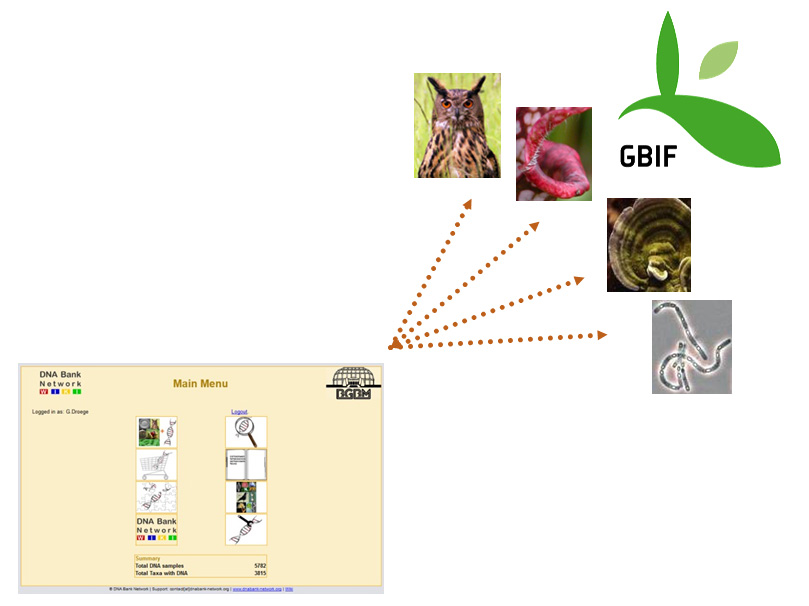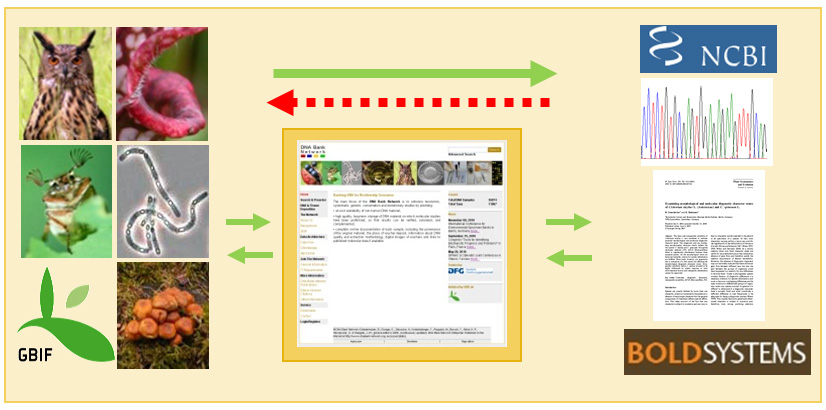Difference between revisions of "Main Page"
From GGBN Wiki
(→What is GBIF?) |
|||
| Line 3: | Line 3: | ||
[[File:Image.jpg]] | [[File:Image.jpg]] | ||
| − | These wiki sites | + | These wiki sites leads you trough installing and use of the open source software "DNA Module" and will guide you to join the DNA Bank Network. |
| − | = | + | =The DNA Module= |
| − | + | * Manage your DNA collection and customer requests with an open source software | |
| − | + | * Set references to voucher specimens by using GBIF infrastructure | |
| − | + | * Get original specimen data from GBIF providers instead of copies | |
| + | * Set links to NCBI, EMBL, DDBJ, or BOLD | ||
| + | * Set references to publications | ||
| + | * Use the Specimen Tool for specimen data that are not available via GBIF | ||
| + | * Share you DNA data with others | ||
| + | * Find out more about the [[DNA Module]] | ||
| + | [[File:Start1.jpg|thumb|650px|The DNA Module can interact with every GBIF compliant database]] | ||
| − | = | + | =The Network= |
| − | + | * Administer your data locally | |
| − | + | * Share your data with the world | |
| + | * Join the DNA Bank Network with your DNA Bank | ||
| + | * Join GBIF with your specimen and observation records | ||
| + | * Let other scientists find and order your DNA samples via a central platform | ||
| + | * Help us to bridge the gap between natural history collections and sequence portals | ||
| + | * Find out more about how to [[Join the Network]] | ||
| + | [[File:Start2.jpg|thumb|650px|The data architecture of the DNA Bank Network holds the potential to become an international platform of biological DNA banks to bridge the gap between natural history collections and molecular sequence databases.]] | ||
| − | = | + | =ABCDDNA and BioCASE= |
| − | + | * Use this powerful team for exchange and transfer of DNA data | |
| − | + | * More than 30 Mio. records are provided to GBIF with BioCASE | |
| − | + | * Find out more about the pros of [[ABCDDNA]] and [http://wiki.bgbm.org/bps/index.php/Main_Page BioCASE] | |
| − | |||
| − | |||
| − | |||
| − | * | ||
| − | |||
| − | |||
| − | |||
| − | |||
| − | |||
| − | |||
| − | * | ||
| − | |||
| − | |||
| − | |||
| − | |||
| − | |||
| − | |||
| − | |||
| − | |||
| − | |||
| − | |||
| − | |||
| − | |||
| − | |||
| − | |||
| − | |||
| − | |||
| − | |||
| − | |||
| − | |||
| − | |||
| − | |||
| − | |||
Revision as of 12:03, 10 February 2012
Welcome to the DNA Bank Network Wiki!
These wiki sites leads you trough installing and use of the open source software "DNA Module" and will guide you to join the DNA Bank Network.
The DNA Module
- Manage your DNA collection and customer requests with an open source software
- Set references to voucher specimens by using GBIF infrastructure
- Get original specimen data from GBIF providers instead of copies
- Set links to NCBI, EMBL, DDBJ, or BOLD
- Set references to publications
- Use the Specimen Tool for specimen data that are not available via GBIF
- Share you DNA data with others
- Find out more about the DNA Module
The Network
- Administer your data locally
- Share your data with the world
- Join the DNA Bank Network with your DNA Bank
- Join GBIF with your specimen and observation records
- Let other scientists find and order your DNA samples via a central platform
- Help us to bridge the gap between natural history collections and sequence portals
- Find out more about how to Join the Network


